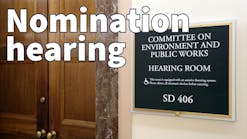The U.S. Environmental Protection Agency (EPA) has announced a strategy for expanding and strengthening sewage sludge (biosolids) research and programs. Under the strategy, which responds to recommendations of the National Academy of Sciences' National Research Council, EPA will undertake to update the science underlying the rule by conducting research in priority areas.
EPA's plans to use that research to strengthen the sewage sludge program. It will also work to increase partnerships and communication with the public and other stakeholders.
"Today's announcement is EPA's effort to address the recommendations of the National Academy of Sciences as well as citizen concerns while maintaining the beneficial uses of biosolids," said G. Tracy Mehan, III, Assistant Administrator for Water.
Two years ago, EPA commissioned the National Academy of Sciences to independently review the scientific basis of the regulations governing the land application of sewage sludge. The 18-month study, called "Biosolids Applied to Land: Advancing Standards and Practices," was published in July 2002. The National Academy of Sciences concluded that while there is no documented scientific evidence that sewage sludge regulations have failed to protect public health, there is persistent uncertainty on possible adverse health effects.
EPA published a Federal Register notice on April 9, outlining it's plans.
In the same notice, EPA also announced preliminary results of its review of existing sewage sludge regulations as required by the Clean Water Act, which is required every two years. EPA reported that it has not identified any additional toxic pollutants that warrant regulation in sewage sludge.
The next step in identifying chemicals that may warrant regulation is to conduct a screening analysis of those chemicals for which adequate data and analytical methods are available and for which there is evidence that they may occur in sewage sludge. EPA plans to complete this screening analysis by January 2004.
EPA Releases Septic Tank Guidance
Stressing the environmental importance of proper septic tank management to prevent pollution from entering the nation's rivers, lakes, coasts, and groundwater, EPA is providing approximately 4,000 city and county public health officials with materials to educate citizens about proper septic system management.
Failing and improperly managed septic systems are a significant source of water pollution, potentially causing contamination of drinking water wells or restricting shellfish harvest. Septic systems serve approximately 25 percent of U.S. households, and one in every three new homes built today uses these systems – making proper maintenance essential for protecting America's waters.
"Public education is the key to improving septic system management. Citizens need to better understand the potential harm improperly managed septic systems can have on the environment and public health and what they can do to help," said EPA Assistant Administrator for Water G. Tracy Mehan, III.
As part of EPA's year-long celebration of the 30th anniversary of the Clean Water Act, the Agency has developed a CD-based kit that communities can use to reach out to citizens. Using the CD, communities can inexpensively produce customized versions of brochures, utility bill inserts, and other useful information. Each document contains space where communities can add local information, so citizens will know how to obtain additional information.
To order copies of the Wastewater Month CD or hard copies of these materials, visit the Wastewater Month website at www.epa.gov/npdes/wastewatermonth or contact Nikos Singelis, of the Office of Wastewater Management, at [email protected].


